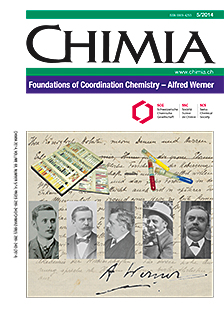The Color of Complexes and UV-vis Spectroscopy as an Analytical Tool of Alfred Werner's Group at the University of Zurich
DOI:
https://doi.org/10.2533/chimia.2014.307Keywords:
Coordination compounds, History of chemistry, Structure of complexes, Werner, alfred, Uv-vis spectroscopyAbstract
Two PhD theses (Alexander Gordienko, 1912; Johannes Angerstein, 1914) and a dissertation in partial fulfillment of a PhD thesis (H. S. French, Zurich, 1914) are reviewed that deal with hitherto unpublished UV-vis spectroscopy work of coordination compounds in the group of Alfred Werner. The method of measurement of UV-vis spectra at Alfred Werner's time is described in detail. Examples of spectra of complexes are given, which were partly interpreted in terms of structure (cis ? trans configuration, counting number of bands for structural relationships, and shift of general spectral features by consecutive replacement of ligands). A more complete interpretation of spectra was hampered at Alfred Werner's time by the lack of a light absorption theory and a correct theory of electron excitation, and the lack of a ligand field theory for coordination compounds. The experimentally difficult data acquisitions and the difficult spectral interpretations might have been reasons why this method did not experience a breakthrough in Alfred Werner's group to play a more prominent role as an important analytical method. Nevertheless the application of UV-vis spectroscopy on coordination compounds was unique and novel, and witnesses Alfred Werner's great aptitude and keenness to always try and go beyond conventional practice.Downloads
Published
2014-05-28
Issue
Section
Scientific Articles
License
Copyright (c) 2014 Swiss Chemical Society

This work is licensed under a Creative Commons Attribution-NonCommercial 4.0 International License.
How to Cite
[1]
Chimia 2014, 68, 307, DOI: 10.2533/chimia.2014.307.







